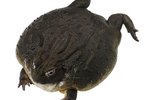
The common rain frog, also known as Breviceps adspersus or the Bushveld rain frog, is one of at least 19 species of rain frogs. This frog prefers to live in the dry sandy areas of southern African, including the Kalahari sand dunes. These frogs are not considered to be threatened and have a range of adaptations they use as protection from predators and environmental dangers.
Burrowing Backward
Rain frogs protect themselves by burrowing into the sandy soils of southern Africa. This medium-sized, round frog has short, strong legs that help it dig backwards into ground where it stays moist and cool while avoiding predators. The burrows can range from 50 to 60 centimeters in length and constructed with two entrances. So, not only can rain frogs hide underground, but they can escape out their back doors when danger digs at the front door.
Camouflaged Comfort
The skin color of the common rain frog helps it blend in with its environment. The frog sports shades of light and dark brown with variable back patterns. They often have spots and patches, which may contain bits of yellow or orange, and a broad black stripe extends from the eye to the armpit. Their undersides are white, and sometimes mottled. This color combination, along with sticky dirt from their burrows, helps these frogs stay disguised while living as a ground dwellers.
Slip Sliding Away
The rain frogs have granular glands on their skin that release skin secretions as a protective mechanism against predators. Like other frogs, the skin secretions may be noxious and unpleasant tasting to the predator, although the common rain frog's skin secretions have not yet been studied. Also, the skin secretions lead to increased mucus production. Increased mucus production means the frog is more slippery when a predator is trying to catch it, thus allowing it a better chance of escape.
Puffed Up to Predators
Another defense mechanism that the common rain frog uses is its ability to appear larger than its normal size. When threatened, this frog will puff itself up to appear larger as a deterrent to predators. Also, the larger size may make it more difficult for a predator to consume a frog, depending on the size of the predator. For example, a small snake trying to eat a common rain frog may have difficulty as the frog enlarges itself, while a black-backed jackal would not be discouraged.
Hibernating Frogs
Hibernation protects the common rain frogs from weather and low food supply. During the dry season, these frogs form mucous cocoons around their bodies to prevent water loss while deep in their burrows. They emerge from hibernation from late September to October, which coincides with their main source of food, swarming termites. Coming out of hibernation also coincides with the rainy season, an important time for these frogs to breed.
References
- Amphibiaweb: Search for Rain Frog
- International Union for Conservation of Nature and Natural Resources, IUCN Redlist: Breviceps Adspersus
- Education LifeDesks: Breviceps Adspersus
- Amphibiaweb: Breviceps Adspersus
- Missouri Department of Conservation: Toads and Frogs
- Southern African Herpetology: Amphibians, Frogs
Photo Credits
-
Goodshoot/Goodshoot/Getty Images
Writer Bio
Based in Michigan, Keri Gardner has been writing scientific journal articles since 1998. Her articles have appeared in such journals as "Disability and Rehabilitation" and "Journal of Orthopaedic Research." She holds a Master of Science in comparative medicine and integrative biology from Michigan State University.


